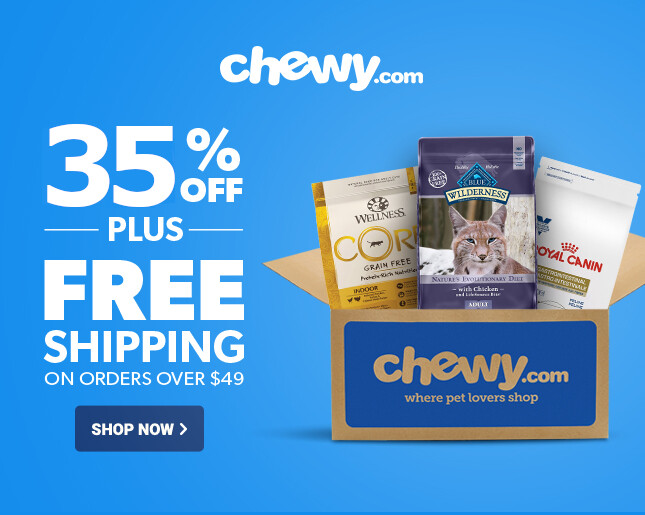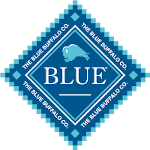
Blue Buffalo Cat Food Ingredients
According to our research, Blue Buffalo manufactures 130 cat food recipes using 167 unique ingredients. To evaluate the quality of ingredients used by Blue Buffalo, we've studied all 167 ingredients. In this article, we'll share our findings on Blue Buffalo ingredients.
| Cat Food Recipes | 130 |
| Unique Ingredients | 167 |
| Artificial Colors | 0 |
| Animal By-Products | 0 |
| Anonymous Meats | 2 |
| Controversial | 5 |
| Harmful | 1 |
First 5 Ingredients
Cat food ingredients in the United States are listed in descending order of pre-cooked weight. The first 5 ingredients typically constitute a significant portion of the recipe.
For Blue Buffalo, these are the most common ingredients found within the first 5 cat food ingredients.
- chicken
- chicken meal
- water
- pea
- chicken liver
As you can see, the most common first ingredient in Blue Buffalo is chicken. The most common 2nd ingredient is chicken meal, followed by water, pea, and chicken liver.
Artificial Food Coloring Dyes
Blue Buffalo does not use any artificial food coloring dyes. According to our records, none of the 130 Blue Buffalo cat foods contain artificial food dyes.
Artificial food coloring dyes are unnecessary and potentially harmful ingredients. In general, we not not recommend feeding any pet foods that contain artificial dyes.
In 2010, the CSPI raised serious concerns regarding the safety of many artificial dyes. Most of the studies referenced by the CSPI involved prolonged or excessive consumption. Since most cats consume the same foods throughout their lives, concerns raised by the CSPI are alarming to say the least.
To read more about Artificial Food Dyes, click here.
Animal By-Products
According to our records, Blue Buffalo does not contain any animal by-products.
Animal by-products are basically the leftover parts of the the carcass after its been processed for meat. AAFCO defines by-products as the non-rendered, clean parts, other than meat, derived from slaughtered mammals.
Although by-products are still fairly nutritious ingredients, consumers have equated them with slaughterhouse waste. Therefore, most premium brands, including Blue Buffalo have decided to remove by-products and instead use named organ meats (beef liver, chicken gizzards).
For further reading on the controversy over animal by-products, click here.
Anonymous Meat Ingredients
Anonymous meats are animal-based ingredients which do not provide the source animal's name. These ingredients are controversial because they can come from almost any animal.
In addition, anonymous animal-based ingredients are very inexpensive and often the lowest quality meats that are still allowed to be used in pet food.
In general, we do not recommend feeding any products which contain anonymous meats. When in doubt, always contact the brand's customer service desk for further clarification.
Unfortunately, we've identified 2 anonymous meat ingredients used by Blue Buffalo.
Fish is typically an excellent protein and fat source. However, the specific type of fish is not mentioned and therefore we cannot discuss any specific qualities of this ingredient. In general, anonymous ingredients are low quality inclusions when compared to ingredients such as mackerel, cod, salmon, etc.
The following recipes contain fish:
Fish meal is defined by AAFCO as "the clean, dried, ground tissue of undecomposed whole fish or fish cutting, either or both, with or without the extraction of part of the oil." Since the specific type of fish is not mentioned, we cannot discuss any specific qualities of this ingredient. In general, anonymous ingredients are low quality inclusions when compared to ingredients such as tuna meal, salmon meal, catfish meal, etc.
The following recipes contain fish meal:
Cereal Grains
Certain Blue Buffalo cat food recipes contain one or more grains. The specific ingredients are listed below.
For cats, we typically recommend choosing a grain-free recipe. Cats are obligate carnivores and therefore grains are not species appropriate.
The kibble production requires a binding agent. Grains are commonly used for this purpose in cat food. When purchasing grain-free cat food, grains are often replaced with another starchy source. This is also not ideal.
To avoid grains and other starchy additions, consider feeding wet or frozen recipes.
The following recipes contain barley grass:
- Blue Buffalo Healthy Growth Chicken & Brown Rice Recipe For Kittens
- Blue Buffalo Freedom Chicken Recipe For Indoor Kittens
- Blue Buffalo Wilderness Chicken Recipe For Kittens
- Blue Buffalo Healthy Living Chicken & Brown Rice Recipe For Adult Cats
- Blue Buffalo Multi-Cat Health Chicken & Turkey Recipe For Adult Cats
- Blue Buffalo Weight Control Chicken and Brown Rice Recipe For Adult Cats
- Blue Buffalo Indoor Hairball & Weight Control Chicken & Brown Rice Recipe For Adult Cats
- Blue Buffalo Sensitive Stomach Chicken & Brown Rice Recipe For Adult Cats
- Blue Buffalo Indoor Hairball Control Chicken & Brown Rice Recipe For Adult Cats
- Blue Buffalo Indoor Health Chicken & Brown Rice Recipe For Adult Cats
- Blue Buffalo Indoor Health Salmon & Brown Rice Recipe For Adult Cats
- Blue Buffalo Freedom Chicken Recipe For Indoor Cats
- Blue Buffalo Freedom Fish Recipe For Indoor Cats
- Blue Buffalo Freedom Chicken Recipe For Indoor Weight Control
- Blue Buffalo Basics Limited Ingredient Grain-Free Duck & Potato Recipe For Indoor Adult Cats
- Blue Buffalo Basics Limited Ingredient Grain-Free Fish & Potato Recipe For Indoor Adult Cats
- Blue Buffalo Basics Limited Ingredient Grain-Free Turkey & Potato Recipe For Indoor Adult Cats
- Blue Buffalo Wilderness Chicken Recipe For Adult Cats
- Blue Buffalo Wilderness Duck Recipe For Adult Cats
- Blue Buffalo Wilderness Salmon Recipe For Adult Cats
- Blue Buffalo Wilderness Chicken Recipe For Adult Weight Control
- Blue Buffalo Wilderness Chicken Recipe For Indoor Adult Cats
- Blue Buffalo Wilderness Chicken Recipe For Indoor Hairball Control
- Blue Buffalo Wilderness Chicken Recipe For Indoor Hairball & Weight Control
- Blue Buffalo Wilderness Rocky Mountain Recipe With Trout For Adult Cats
- Blue Buffalo Wilderness Rocky Mountain Recipe With Rabbit For Adult Cats
- Blue Buffalo Wilderness Rocky Mountain Recipe With Red Meat For Adult Cats
- Blue Buffalo Healthy Aging Chicken & Brown Rice Recipe For Mature Cats
- Blue Buffalo Indoor Hairball Control Chicken & Brown Rice Recipe For Mature Cats
- Blue Buffalo Freedom Indoor Mature Chicken Recipe
- Blue Buffalo Basics Turkey & Potato Recipe (Skin & Stomach Care) For Indoor Mature Cats
- Blue Buffalo Wilderness Chicken Recipe For Mature Cats
- Blue Buffalo Natural Veterinary Diet GI Gastrointestinal Support
- Blue Buffalo Natural Veterinary Diet WU Weight Management + Urinary Care
- Blue Buffalo Natural Veterinary Diet KM Kidney + Mobility Support
- Blue Buffalo Indoor Health Grain-Free Chicken Recipe For Adult Cats
- Blue Buffalo Wilderness Denali Dinner With Wild Salmon, Venison & Halibut For Cats
- Blue Buffalo Wilderness Flatland Feast With Turkey, Quail & Duck For Cats
- Blue Buffalo Baby Blue Chicken and Brown Rice Recipe For Kittens
- Blue Buffalo Baby Blue Grain-Free Chicken and Pea Recipe For Kittens
- Blue Buffalo True Solutions Perfect Coat (Skin & Coat Care Formula) For Cats
- Blue Buffalo True Solutions Fit & Healthy Weight Control Formula For Cats
- Blue Buffalo True Solutions Blissful Belly Digestive Care Formula For Cats
- Blue Buffalo True Solutions Fab Feline Formula For Indoor Cats
- Blue Buffalo True Solutions Hairball Control Formula For Cats
Barley is a nutritious carbohydrate source, naturally rich in dietary fiber and various minerals. Unlike pearled barley, regular barley contains the entire grain.
The following recipes contain barley:
- Blue Buffalo Healthy Growth Chicken & Brown Rice Recipe For Kittens
- Blue Buffalo Healthy Living Chicken & Brown Rice Recipe For Adult Cats
- Blue Buffalo Multi-Cat Health Chicken & Turkey Recipe For Adult Cats
- Blue Buffalo Weight Control Chicken and Brown Rice Recipe For Adult Cats
- Blue Buffalo Indoor Hairball & Weight Control Chicken & Brown Rice Recipe For Adult Cats
- Blue Buffalo Sensitive Stomach Chicken & Brown Rice Recipe For Adult Cats
- Blue Buffalo Indoor Hairball Control Chicken & Brown Rice Recipe For Adult Cats
- Blue Buffalo Indoor Health Chicken & Brown Rice Recipe For Adult Cats
- Blue Buffalo Indoor Health Salmon & Brown Rice Recipe For Adult Cats
- Blue Buffalo Healthy Aging Chicken & Brown Rice Recipe For Mature Cats
- Blue Buffalo Indoor Hairball Control Chicken & Brown Rice Recipe For Mature Cats
- Blue Buffalo Kitty Cravings With Real Tuna
- Blue Buffalo Kitty Cravings With Real Shrimp
- Blue Buffalo Kitty Cravings With Real Chicken
- Blue Buffalo Kitty Cravings With Real Salmon
- Blue Buffalo Baby Blue Chicken and Brown Rice Recipe For Kittens
- Blue Buffalo Baby Blue Kitten Crunchies Savory Chicken Treats
- Blue Buffalo True Solutions Perfect Coat (Skin & Coat Care Formula) For Cats
- Blue Buffalo True Solutions Fit & Healthy Weight Control Formula For Cats
- Blue Buffalo True Solutions Blissful Belly Digestive Care Formula For Cats
- Blue Buffalo Bursts With Paw-Lickin' Chicken
- Blue Buffalo Bursts With Delish Liver & Beef
- Blue Buffalo Bursts With Savory Seafood
- Blue Buffalo True Solutions Fab Feline Formula For Indoor Cats
- Blue Buffalo True Solutions Hairball Control Formula For Cats
Brown rice is naturally rich in fiber and various minerals including manganese, phosphorus, and magnesium. Relative to other grains, brown rice is easy to digest.
The following recipes contain brown rice:
- Blue Buffalo Healthy Growth Chicken & Brown Rice Recipe For Kittens
- Blue Buffalo Healthy Living Chicken & Brown Rice Recipe For Adult Cats
- Blue Buffalo Multi-Cat Health Chicken & Turkey Recipe For Adult Cats
- Blue Buffalo Weight Control Chicken and Brown Rice Recipe For Adult Cats
- Blue Buffalo Indoor Hairball & Weight Control Chicken & Brown Rice Recipe For Adult Cats
- Blue Buffalo Sensitive Stomach Chicken & Brown Rice Recipe For Adult Cats
- Blue Buffalo Indoor Hairball Control Chicken & Brown Rice Recipe For Adult Cats
- Blue Buffalo Indoor Health Chicken & Brown Rice Recipe For Adult Cats
- Blue Buffalo Indoor Health Salmon & Brown Rice Recipe For Adult Cats
- Blue Buffalo Healthy Aging Chicken & Brown Rice Recipe For Mature Cats
- Blue Buffalo Indoor Hairball Control Chicken & Brown Rice Recipe For Mature Cats
- Blue Buffalo Tastefuls Chicken Entree For Kittens (Paté)
- Blue Buffalo Tastefuls Beef Entree (Paté)
- Blue Buffalo Tastefuls Ocean Fish & Tuna Entree (Paté)
- Blue Buffalo Tastefuls Turkey and Chicken Entree (Paté)
- Blue Buffalo Tastefuls Chicken Entree (Paté)
- Blue Buffalo Tastefuls Salmon Entree (Paté)
- Blue Buffalo Tastefuls Chicken Entree In Gravy (Flaked)
- Blue Buffalo Tastefuls Tuna Entree In Gravy (Flaked)
- Blue Buffalo Tastefuls Fish and Shrimp Entree In Gravy (Flaked)
- Blue Buffalo Tastefuls Chicken Entree In Savory Sauce (Tender Morsels)
- Blue Buffalo Tastefuls Tuna Entree In Savory Sauce (Tender Morsels)
- Blue Buffalo Tastefuls Salmon Entree In Gravy (Flaked)
- Blue Buffalo Tastefuls Chicken Entree For Mature Cats (Paté)
- Blue Buffalo Kitty Cravings With Real Tuna
- Blue Buffalo Kitty Cravings With Real Shrimp
- Blue Buffalo Kitty Cravings With Real Chicken
- Blue Buffalo Kitty Cravings With Real Salmon
- Blue Buffalo Baby Blue Chicken and Brown Rice Recipe For Kittens
- Blue Buffalo Baby Blue Chicken Recipe For Kittens
- Blue Buffalo Baby Blue Kitten Crunchies Savory Chicken Treats
- Blue Buffalo True Solutions Perfect Coat (Skin & Coat Care Formula) For Cats
- Blue Buffalo True Solutions Fit & Healthy Weight Control Formula For Cats
- Blue Buffalo True Solutions Blissful Belly Digestive Care Formula For Cats
- Blue Buffalo True Solutions Fit & Healthy Weight Control Formula Canned Cat Food
- Blue Buffalo True Solutions Perfect Coat (Skin and Coat Care Formula) Canned Cat Food
- Blue Buffalo True Solutions Blissful Belly Digestive Care Formula Canned Cat Food
- Blue Buffalo Bursts With Paw-Lickin' Chicken
- Blue Buffalo Bursts With Delish Liver & Beef
- Blue Buffalo Bursts With Savory Seafood
- Blue Buffalo True Solutions Fab Feline Formula For Indoor Cats
- Blue Buffalo True Solutions Fab Feline Formula For Indoor Cats (Canned Cat Food)
- Blue Buffalo True Solutions Hairball Control Formula For Cats
- Blue Buffalo Tastefuls Savory Singles Chicken Entrée Cuts In Gravy
- Blue Buffalo Tastefuls Savory Singles Salmon Entrée Cuts In Gravy
- Blue Buffalo Tastefuls Savory Singles Tuna Entrée Cuts In Gravy
- Blue Buffalo Tastefuls Savory Singles Turkey Entrée Cuts In Gravy
- Blue Buffalo Tastefuls Spoonless Singles Chicken Entrée Savory Paté
- Blue Buffalo Tastefuls Spoonless Singles Whitefish and Tuna Entrée Savory Paté
- Blue Buffalo Tastefuls Spoonless Singles Salmon Entrée Savory Paté
- Blue Buffalo Tastefuls Spoonless Singles Turkey Entrée Savory Paté
- Blue Buffalo Tastefuls Spoonless Singles Beef Entrée Savory Paté
Oatmeal is simply coarsely ground oats and therefore contains the entire oat grain. As with regular oats, oatmeal is rich in dietary fiber, B vitamins, and various minerals.
The following recipes contain oatmeal:
- Blue Buffalo Healthy Growth Chicken & Brown Rice Recipe For Kittens
- Blue Buffalo Healthy Living Chicken & Brown Rice Recipe For Adult Cats
- Blue Buffalo Multi-Cat Health Chicken & Turkey Recipe For Adult Cats
- Blue Buffalo Weight Control Chicken and Brown Rice Recipe For Adult Cats
- Blue Buffalo Sensitive Stomach Chicken & Brown Rice Recipe For Adult Cats
- Blue Buffalo Indoor Hairball Control Chicken & Brown Rice Recipe For Adult Cats
- Blue Buffalo Indoor Health Chicken & Brown Rice Recipe For Adult Cats
- Blue Buffalo Indoor Health Salmon & Brown Rice Recipe For Adult Cats
- Blue Buffalo Healthy Aging Chicken & Brown Rice Recipe For Mature Cats
- Blue Buffalo Indoor Hairball Control Chicken & Brown Rice Recipe For Mature Cats
- Blue Buffalo Kitty Cravings With Real Tuna
- Blue Buffalo Kitty Cravings With Real Shrimp
- Blue Buffalo Kitty Cravings With Real Chicken
- Blue Buffalo Kitty Cravings With Real Salmon
- Blue Buffalo Baby Blue Chicken and Brown Rice Recipe For Kittens
- Blue Buffalo Baby Blue Kitten Crunchies Savory Chicken Treats
- Blue Buffalo True Solutions Perfect Coat (Skin & Coat Care Formula) For Cats
- Blue Buffalo True Solutions Blissful Belly Digestive Care Formula For Cats
- Blue Buffalo Bursts With Paw-Lickin' Chicken
- Blue Buffalo Bursts With Delish Liver & Beef
- Blue Buffalo Bursts With Savory Seafood
- Blue Buffalo True Solutions Fab Feline Formula For Indoor Cats
- Blue Buffalo True Solutions Hairball Control Formula For Cats
Controversial Ingredients
In most cases, ingredients which are given the controversial classification can be substituted with higher-quality alternatives. You should evaluate each controversial ingredient independently to see if there is truly a valid cause for concern.
Keep in mind, certain sacrifices often must be made to produce cat foods at a reasonable price. In general, the more expensive the product, the fewer controversial ingredients you'll find.
In our analysis, we've identified 5 controversial ingredients inside Blue Buffalo products. These controversial ingredients are listed below. Click on each ingredient for more information.
Dried tomato pomace is a by-product of tomato manufacturing. It's considered a controversial ingredient because many people believe it is an inexpensive low quality filler. However, tomato pomace provides a notable amount of dietary fiber, B vitamins, Lycopene, and vitamin A. Although it is a very inexpensive ingredient, it is not nutritionally empty.
The following recipes contain dried tomato pomace:
- Blue Buffalo Multi-Cat Health Chicken & Turkey Recipe For Adult Cats
- Blue Buffalo Indoor Hairball & Weight Control Chicken & Brown Rice Recipe For Adult Cats
- Blue Buffalo True Solutions Perfect Coat (Skin & Coat Care Formula) For Cats
- Blue Buffalo True Solutions Fit & Healthy Weight Control Formula For Cats
- Blue Buffalo True Solutions Blissful Belly Digestive Care Formula For Cats
- Blue Buffalo True Solutions Fab Feline Formula For Indoor Cats
- Blue Buffalo True Solutions Hairball Control Formula For Cats
Powdered cellulose is produced from minuscule pieces of wood pulp and plant fibers. Other than its fiber content, powdered cellulose lacks any nutritional contribution.
The following recipes contain powdered cellulose:
- Blue Buffalo Healthy Growth Chicken & Brown Rice Recipe For Kittens
- Blue Buffalo Freedom Chicken Recipe For Indoor Kittens
- Blue Buffalo Weight Control Chicken and Brown Rice Recipe For Adult Cats
- Blue Buffalo Indoor Hairball & Weight Control Chicken & Brown Rice Recipe For Adult Cats
- Blue Buffalo Indoor Hairball Control Chicken & Brown Rice Recipe For Adult Cats
- Blue Buffalo Indoor Health Chicken & Brown Rice Recipe For Adult Cats
- Blue Buffalo Indoor Health Salmon & Brown Rice Recipe For Adult Cats
- Blue Buffalo Freedom Chicken Recipe For Indoor Cats
- Blue Buffalo Freedom Fish Recipe For Indoor Cats
- Blue Buffalo Freedom Chicken Recipe For Indoor Weight Control
- Blue Buffalo Wilderness Chicken Recipe For Adult Weight Control
- Blue Buffalo Wilderness Chicken Recipe For Indoor Adult Cats
- Blue Buffalo Wilderness Chicken Recipe For Indoor Hairball Control
- Blue Buffalo Wilderness Chicken Recipe For Indoor Hairball & Weight Control
- Blue Buffalo Healthy Aging Chicken & Brown Rice Recipe For Mature Cats
- Blue Buffalo Indoor Hairball Control Chicken & Brown Rice Recipe For Mature Cats
- Blue Buffalo Freedom Indoor Mature Chicken Recipe
- Blue Buffalo Freedom Indoor Kitten Chicken Recipe
- Blue Buffalo Basics Limited Ingredient Grain-Free Indoor Kitten Turkey & Potato Entree
- Blue Buffalo Tastefuls Beef Entree (Paté)
- Blue Buffalo Tastefuls Chicken Entree (Paté)
- Blue Buffalo Tastefuls Salmon Entree (Paté)
- Blue Buffalo Freedom Indoor Chicken Recipe
- Blue Buffalo Freedom Indoor Fish Recipe
- Blue Buffalo Freedom Flaked Indoor Chicken Recipe
- Blue Buffalo Basics Limited Ingredient Grain-Free Indoor Turkey & Potato Entree
- Blue Buffalo Tastefuls Chicken Entree For Mature Cats (Paté)
- Blue Buffalo Freedom Chicken Recipe For Indoor Mature Cats
- Blue Buffalo Natural Veterinary Diet WU Weight Management + Urinary Care
- Blue Buffalo Natural Veterinary Diet KM Kidney + Mobility Support
- Blue Buffalo Natural Veterinary Diet WU Weight Management + Urinary Care
- Blue Buffalo Indoor Health Grain-Free Chicken Recipe For Adult Cats
- Blue Buffalo Baby Blue Chicken and Brown Rice Recipe For Kittens
- Blue Buffalo True Solutions Fit & Healthy Weight Control Formula For Cats
- Blue Buffalo True Solutions Fit & Healthy Weight Control Formula Canned Cat Food
- Blue Buffalo True Solutions Perfect Coat (Skin and Coat Care Formula) Canned Cat Food
- Blue Buffalo True Solutions Fab Feline Formula For Indoor Cats (Canned Cat Food)
- Blue Buffalo True Solutions Hairball Control Formula For Cats
- Blue Buffalo Tastefuls Spoonless Singles Chicken Entrée Savory Paté
- Blue Buffalo Tastefuls Spoonless Singles Salmon Entrée Savory Paté
- Blue Buffalo Tastefuls Spoonless Singles Beef Entrée Savory Paté
Pea protein is produced by removing the starchy parts of peas. Pea protein is considered controversial because it provides a substantial plant based protein boost. This boost is undesirable because plant based protein is typically lower in biological value when compared to meat based proteins.
The following recipes contain pea protein:
- Blue Buffalo Healthy Growth Chicken & Brown Rice Recipe For Kittens
- Blue Buffalo Freedom Chicken Recipe For Indoor Kittens
- Blue Buffalo Wilderness Chicken Recipe For Kittens
- Blue Buffalo Healthy Living Chicken & Brown Rice Recipe For Adult Cats
- Blue Buffalo Multi-Cat Health Chicken & Turkey Recipe For Adult Cats
- Blue Buffalo Weight Control Chicken and Brown Rice Recipe For Adult Cats
- Blue Buffalo Indoor Hairball & Weight Control Chicken & Brown Rice Recipe For Adult Cats
- Blue Buffalo Sensitive Stomach Chicken & Brown Rice Recipe For Adult Cats
- Blue Buffalo Indoor Health Chicken & Brown Rice Recipe For Adult Cats
- Blue Buffalo Indoor Health Salmon & Brown Rice Recipe For Adult Cats
- Blue Buffalo Freedom Chicken Recipe For Indoor Cats
- Blue Buffalo Freedom Fish Recipe For Indoor Cats
- Blue Buffalo Freedom Chicken Recipe For Indoor Weight Control
- Blue Buffalo Basics Limited Ingredient Grain-Free Duck & Potato Recipe For Indoor Adult Cats
- Blue Buffalo Basics Limited Ingredient Grain-Free Fish & Potato Recipe For Indoor Adult Cats
- Blue Buffalo Basics Limited Ingredient Grain-Free Turkey & Potato Recipe For Indoor Adult Cats
- Blue Buffalo Wilderness Chicken Recipe For Adult Cats
- Blue Buffalo Wilderness Duck Recipe For Adult Cats
- Blue Buffalo Wilderness Salmon Recipe For Adult Cats
- Blue Buffalo Wilderness Chicken Recipe For Adult Weight Control
- Blue Buffalo Wilderness Chicken Recipe For Indoor Adult Cats
- Blue Buffalo Wilderness Chicken Recipe For Indoor Hairball Control
- Blue Buffalo Wilderness Chicken Recipe For Indoor Hairball & Weight Control
- Blue Buffalo Wilderness Rocky Mountain Recipe With Trout For Adult Cats
- Blue Buffalo Wilderness Rocky Mountain Recipe With Rabbit For Adult Cats
- Blue Buffalo Wilderness Rocky Mountain Recipe With Red Meat For Adult Cats
- Blue Buffalo Healthy Aging Chicken & Brown Rice Recipe For Mature Cats
- Blue Buffalo Indoor Hairball Control Chicken & Brown Rice Recipe For Mature Cats
- Blue Buffalo Freedom Indoor Mature Chicken Recipe
- Blue Buffalo Basics Turkey & Potato Recipe (Skin & Stomach Care) For Indoor Mature Cats
- Blue Buffalo Wilderness Chicken Recipe For Mature Cats
- Blue Buffalo Basics Grain-Free Indoor Duck & Potato Entree
- Blue Buffalo Basics Indoor Cat Fish & Potato Entrée (Skin & Stomach Care)
- Blue Buffalo Wilderness Chicken Recipe For Mature Cats
- Blue Buffalo Natural Veterinary Diet HF Hydrolyzed For Food Intolerance For Cats
- Blue Buffalo Natural Veterinary Diet GI Gastrointestinal Support
- Blue Buffalo Natural Veterinary Diet GI Gastrointestinal Support
- Blue Buffalo Natural Veterinary Diet WU Weight Management + Urinary Care
- Blue Buffalo Natural Veterinary Diet KM Kidney + Mobility Support
- Blue Buffalo Natural Veterinary Diet WU Weight Management + Urinary Care
- Blue Buffalo Indoor Health Grain-Free Chicken Recipe For Adult Cats
- Blue Buffalo Wilderness Denali Dinner With Wild Salmon, Venison & Halibut For Cats
- Blue Buffalo Wilderness Flatland Feast With Turkey, Quail & Duck For Cats
- Blue Buffalo Natural Veterinary Diet NP Novel Protein Alligator For Cats
- Blue Buffalo Natural Veterinary Diet NP Novel Protein Alligator For Cats (Canned)
- Blue Buffalo Baby Blue Chicken and Brown Rice Recipe For Kittens
- Blue Buffalo Baby Blue Grain-Free Chicken and Pea Recipe For Kittens
- Blue Buffalo True Solutions Perfect Coat (Skin & Coat Care Formula) For Cats
- Blue Buffalo True Solutions Fit & Healthy Weight Control Formula For Cats
- Blue Buffalo True Solutions Blissful Belly Digestive Care Formula For Cats
Caramel color is a concentrated form of caramel, a natural food colorant. Caramel color has been linked to cancer in laboratory animals. Since our pets do not care about food color, caramel color is an unnecessary addition with possible health risks.
The following recipes contain caramel color:
- Blue Buffalo Indoor Hairball & Weight Control Chicken & Brown Rice Recipe For Adult Cats
- Blue Buffalo Indoor Hairball Control Chicken & Brown Rice Recipe For Adult Cats
- Blue Buffalo Wilderness Chicken Recipe For Indoor Hairball Control
- Blue Buffalo Wilderness Chicken Recipe For Indoor Hairball & Weight Control
Canola oil is a plant-derived oil from the seeds of canola plants. Although fat is an essential component of any diet, canola oil is controversial in pet food. Proponents claim that canola oil provides a better fat profile in comparison to other plant based oils. However, opponents claim that canola oil is typically produced with genetically modified rapeseed and that rapeseed oil has multiple adverse health affects.
The following recipes contain canola oil:
- Blue Buffalo Basics Limited Ingredient Grain-Free Duck & Potato Recipe For Indoor Adult Cats
- Blue Buffalo Basics Limited Ingredient Grain-Free Fish & Potato Recipe For Indoor Adult Cats
- Blue Buffalo Basics Limited Ingredient Grain-Free Turkey & Potato Recipe For Indoor Adult Cats
- Blue Buffalo Wilderness Rocky Mountain Recipe With Trout For Adult Cats
- Blue Buffalo Wilderness Rocky Mountain Recipe With Rabbit For Adult Cats
- Blue Buffalo Wilderness Rocky Mountain Recipe With Red Meat For Adult Cats
- Blue Buffalo Basics Turkey & Potato Recipe (Skin & Stomach Care) For Indoor Mature Cats
- Blue Buffalo Natural Veterinary Diet HF Hydrolyzed For Food Intolerance For Cats
- Blue Buffalo Natural Veterinary Diet NP Novel Protein Alligator For Cats
- Blue Buffalo True Solutions Perfect Coat (Skin & Coat Care Formula) For Cats
- Blue Buffalo True Solutions Fit & Healthy Weight Control Formula For Cats
- Blue Buffalo True Solutions Blissful Belly Digestive Care Formula For Cats
- Blue Buffalo Bursts With Savory Seafood
Potentially Harmful Ingredients
Harmful ingredients are those which have been linked to adverse health effects. In general, we do not recommend feeding any product which contains any harmful ingredients.
There are certain situations where these ingredients may be necessary. We always recommend contacting Blue Buffalo for further clarification regarding any harmful or controversial ingredient.
We have identified 1 harmful ingredient used in certain Blue Buffalo recipes. To learn more, click on the ingredient's name.
Menadione sodium bisulfate complex is a synthetic version of vitamin K that has been linked to many health concerns. Research has suggested possible toxic reactions in liver cells and red blood cells among other serious problems. In fact, one large chemical supplier warns, "The substance is toxic to kidneys, lungs, liver, mucous membranes. Repeated or prolonged exposure to the substance can produce target organs damage."
The following recipes contain menadione sodium bisulfate complex:
Blue Buffalo Cat Food Ingredient Lists

Blue Buffalo
Indoor Health
Grain-Free Chicken Recipe For Adult Cats
Blue Buffalo
Indoor Health Grain-Free Chicken Recipe For Adult Cats
First Five Ingredients
chickenchicken meal
tapioca starch
pea
pea protein
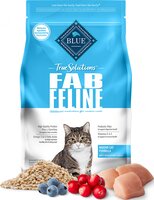
Blue Buffalo
True Solutions
Fab Feline Formula For Indoor Cats
Blue Buffalo
True Solutions Fab Feline Formula For Indoor Cats
First Five Ingredients
chickenchicken meal
oatmeal
brown rice
barley
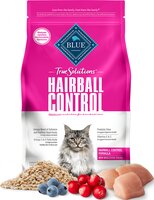
Blue Buffalo
True Solutions
Hairball Control Formula For Cats
Blue Buffalo
True Solutions Hairball Control Formula For Cats
First Five Ingredients
chickenchicken meal
oatmeal
brown rice
barley
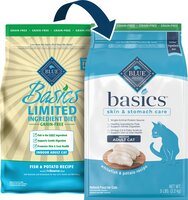
Blue Buffalo
Basics Limited Ingredient Grain-Free
Fish & Potato Recipe For Indoor Adult Cats
Blue Buffalo
Basics Limited Ingredient Grain-Free Fish & Potato Recipe For Indoor Adult Cats
First Five Ingredients
whitefishmenhaden meal
pea protein
potato
pea
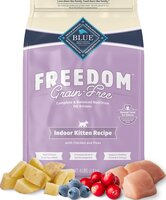
Blue Buffalo
Freedom
Chicken Recipe For Indoor Kittens
Blue Buffalo
Freedom Chicken Recipe For Indoor Kittens
First Five Ingredients
chickenchicken meal
tapioca starch
pea
pea protein
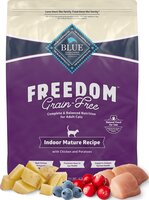
Blue Buffalo
Freedom
Indoor Mature Chicken Recipe
Blue Buffalo
Freedom Indoor Mature Chicken Recipe
First Five Ingredients
chickenchicken meal
tapioca starch
pea
potato
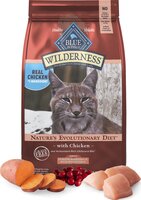
Blue Buffalo
Wilderness
Chicken Recipe For Indoor Hairball & Weight Control
Blue Buffalo
Wilderness Chicken Recipe For Indoor Hairball & Weight Control
First Five Ingredients
chickenchicken meal
tapioca starch
pea protein
pea
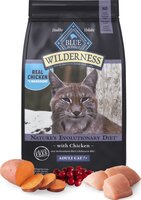
Blue Buffalo
Wilderness
Chicken Recipe For Mature Cats
Blue Buffalo
Wilderness Chicken Recipe For Mature Cats
First Five Ingredients
chickenchicken meal
pea protein
tapioca starch
pea
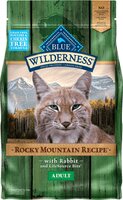
Blue Buffalo
Wilderness Rocky Mountain Recipe
With Rabbit For Adult Cats
Blue Buffalo
Wilderness Rocky Mountain Recipe With Rabbit For Adult Cats
First Five Ingredients
rabbitfish meal
pea protein
pea
tapioca starch

Blue Buffalo
Wilderness Rocky Mountain Recipe
With Trout For Adult Cats
Blue Buffalo
Wilderness Rocky Mountain Recipe With Trout For Adult Cats
First Five Ingredients
troutfish meal
pea protein
tapioca starch
pea
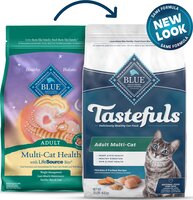
Blue Buffalo
Multi-Cat Health
Chicken & Turkey Recipe For Adult Cats
Blue Buffalo
Multi-Cat Health Chicken & Turkey Recipe For Adult Cats
First Five Ingredients
chickenturkey
chicken meal
brown rice
barley
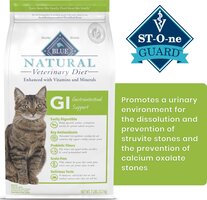
Blue Buffalo
Natural Veterinary Diet
GI Gastrointestinal Support
Blue Buffalo
Natural Veterinary Diet GI Gastrointestinal Support
First Five Ingredients
chickenchicken meal
tapioca starch
pea
pea protein
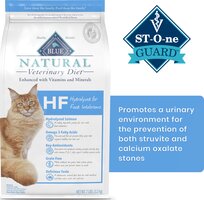
Blue Buffalo
Natural Veterinary Diet
HF Hydrolyzed For Food Intolerance For Cats
Blue Buffalo
Natural Veterinary Diet HF Hydrolyzed For Food Intolerance For Cats
First Five Ingredients
salmon hydrolysatepea
potato
pea starch
canola oil
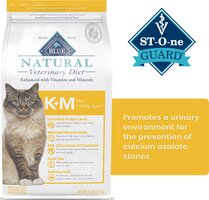
Blue Buffalo
Natural Veterinary Diet
KM Kidney + Mobility Support
Blue Buffalo
Natural Veterinary Diet KM Kidney + Mobility Support
First Five Ingredients
chickenpea
pea starch
potato starch
dried egg product
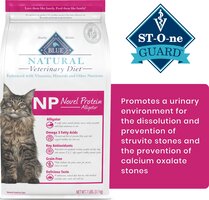
Blue Buffalo
Natural Veterinary Diet
NP Novel Protein Alligator For Cats
Blue Buffalo
Natural Veterinary Diet NP Novel Protein Alligator For Cats
First Five Ingredients
alligatoralligator meal
pea protein
pea starch
pea
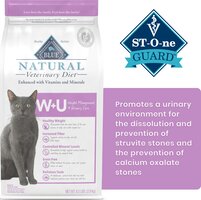
Blue Buffalo
Natural Veterinary Diet
WU Weight Management + Urinary Care
Blue Buffalo
Natural Veterinary Diet WU Weight Management + Urinary Care
First Five Ingredients
chickenchicken meal
pea protein
tapioca starch
powdered cellulose
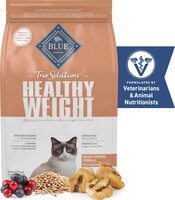
Blue Buffalo
True Solutions
Fit & Healthy Weight Control Formula For Cats
Blue Buffalo
True Solutions Fit & Healthy Weight Control Formula For Cats
First Five Ingredients
chickenchicken meal
pea protein
barley
powdered cellulose
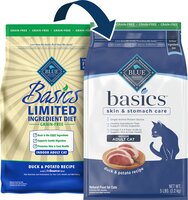
Blue Buffalo
Basics Limited Ingredient Grain-Free
Duck & Potato Recipe For Indoor Adult Cats
Blue Buffalo
Basics Limited Ingredient Grain-Free Duck & Potato Recipe For Indoor Adult Cats
First Five Ingredients
duckduck meal
pea protein
pea
tapioca starch
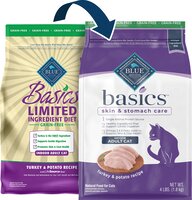
Blue Buffalo
Basics Limited Ingredient Grain-Free
Turkey & Potato Recipe For Indoor Adult Cats
Blue Buffalo
Basics Limited Ingredient Grain-Free Turkey & Potato Recipe For Indoor Adult Cats
First Five Ingredients
turkeyturkey meal
pea protein
pea
tapioca starch
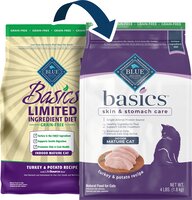
Blue Buffalo
Basics
Turkey & Potato Recipe (Skin & Stomach Care) For Indoor Mature Cats
Blue Buffalo
Basics Turkey & Potato Recipe (Skin & Stomach Care) For Indoor Mature Cats
First Five Ingredients
turkeyturkey meal
pea
potato
tapioca starch
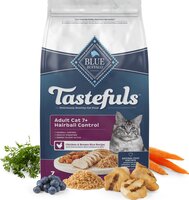
Blue Buffalo
Indoor Hairball Control
Chicken & Brown Rice Recipe For Mature Cats
Blue Buffalo
Indoor Hairball Control Chicken & Brown Rice Recipe For Mature Cats
First Five Ingredients
chickenchicken meal
brown rice
barley
oatmeal
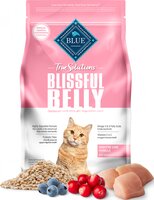
Blue Buffalo
True Solutions
Blissful Belly Digestive Care Formula For Cats
Blue Buffalo
True Solutions Blissful Belly Digestive Care Formula For Cats
First Five Ingredients
chickenchicken meal
brown rice
pea protein
barley
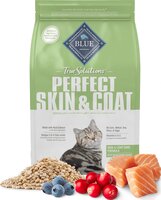
Blue Buffalo
True Solutions
Perfect Coat (Skin & Coat Care Formula) For Cats
Blue Buffalo
True Solutions Perfect Coat (Skin & Coat Care Formula) For Cats
First Five Ingredients
salmonsalmon meal
brown rice
pea protein
barley
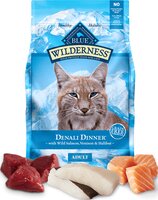
Blue Buffalo
Wilderness
Denali Dinner With Wild Salmon, Venison & Halibut For Cats
Blue Buffalo
Wilderness Denali Dinner With Wild Salmon, Venison & Halibut For Cats
First Five Ingredients
salmonmenhaden meal
tapioca starch
pea
pea protein
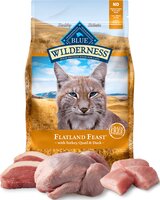
Blue Buffalo
Wilderness
Flatland Feast With Turkey, Quail & Duck For Cats
Blue Buffalo
Wilderness Flatland Feast With Turkey, Quail & Duck For Cats
First Five Ingredients
turkeychicken meal
tapioca starch
pea
pea protein
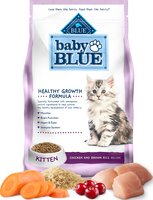
Blue Buffalo
Baby Blue
Chicken and Brown Rice Recipe For Kittens
Blue Buffalo
Baby Blue Chicken and Brown Rice Recipe For Kittens
First Five Ingredients
chickenchicken meal
menhaden meal
brown rice
barley
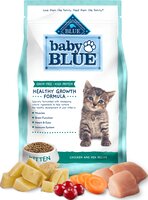
Blue Buffalo
Baby Blue
Grain-Free Chicken and Pea Recipe For Kittens
Blue Buffalo
Baby Blue Grain-Free Chicken and Pea Recipe For Kittens
First Five Ingredients
chickenchicken meal
pea protein
tapioca starch
menhaden meal
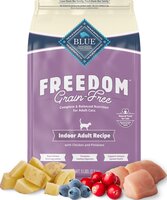
Blue Buffalo
Freedom
Chicken Recipe For Indoor Cats
Blue Buffalo
Freedom Chicken Recipe For Indoor Cats
First Five Ingredients
chickenchicken meal
tapioca starch
pea
pea protein
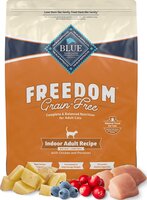
Blue Buffalo
Freedom
Chicken Recipe For Indoor Weight Control
Blue Buffalo
Freedom Chicken Recipe For Indoor Weight Control
First Five Ingredients
chickenchicken meal
tapioca starch
pea
menhaden meal
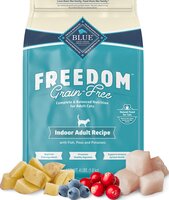
Blue Buffalo
Freedom
Fish Recipe For Indoor Cats
Blue Buffalo
Freedom Fish Recipe For Indoor Cats
First Five Ingredients
whitefishmenhaden meal
tapioca starch
pea
chicken meal
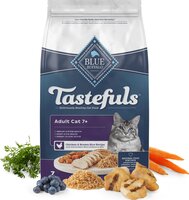
Blue Buffalo
Healthy Aging
Chicken & Brown Rice Recipe For Mature Cats
Blue Buffalo
Healthy Aging Chicken & Brown Rice Recipe For Mature Cats
First Five Ingredients
chickenchicken meal
brown rice
barley
oatmeal
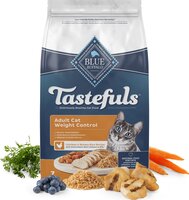
Blue Buffalo
Weight Control
Chicken and Brown Rice Recipe For Adult Cats
Blue Buffalo
Weight Control Chicken and Brown Rice Recipe For Adult Cats
First Five Ingredients
chickenchicken meal
brown rice
barley
oatmeal
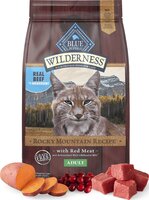
Blue Buffalo
Wilderness Rocky Mountain Recipe
With Red Meat For Adult Cats
Blue Buffalo
Wilderness Rocky Mountain Recipe With Red Meat For Adult Cats
First Five Ingredients
beeffish meal
pea protein
tapioca starch
pea
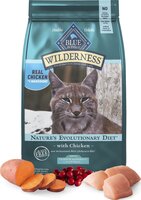
Blue Buffalo
Wilderness
Chicken Recipe For Indoor Hairball Control
Blue Buffalo
Wilderness Chicken Recipe For Indoor Hairball Control
First Five Ingredients
chickenchicken meal
pea protein
tapioca starch
menhaden meal
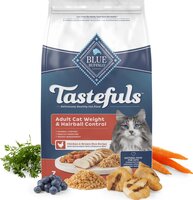
Blue Buffalo
Indoor Hairball & Weight Control
Chicken & Brown Rice Recipe For Adult Cats
Blue Buffalo
Indoor Hairball & Weight Control Chicken & Brown Rice Recipe For Adult Cats
First Five Ingredients
chickenchicken meal
barley
brown rice
menhaden meal
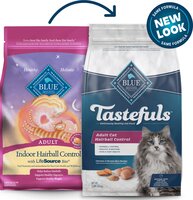
Blue Buffalo
Indoor Hairball Control
Chicken & Brown Rice Recipe For Adult Cats
Blue Buffalo
Indoor Hairball Control Chicken & Brown Rice Recipe For Adult Cats
First Five Ingredients
chickenchicken meal
menhaden meal
brown rice
barley
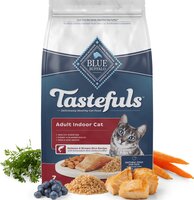
Blue Buffalo
Indoor Health
Salmon & Brown Rice Recipe For Adult Cats
Blue Buffalo
Indoor Health Salmon & Brown Rice Recipe For Adult Cats
First Five Ingredients
salmonchicken meal
brown rice
oatmeal
barley
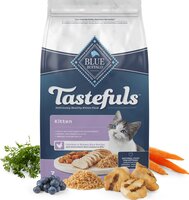
Blue Buffalo
Healthy Growth
Chicken & Brown Rice Recipe For Kittens
Blue Buffalo
Healthy Growth Chicken & Brown Rice Recipe For Kittens
First Five Ingredients
chickenchicken meal
menhaden meal
brown rice
barley
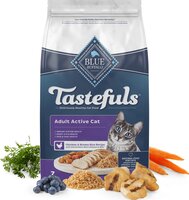
Blue Buffalo
Healthy Living
Chicken & Brown Rice Recipe For Adult Cats
Blue Buffalo
Healthy Living Chicken & Brown Rice Recipe For Adult Cats
First Five Ingredients
chickenchicken meal
brown rice
barley
oatmeal
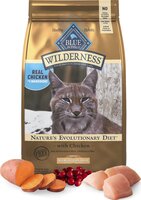
Blue Buffalo
Wilderness
Chicken Recipe For Adult Weight Control
Blue Buffalo
Wilderness Chicken Recipe For Adult Weight Control
First Five Ingredients
chickenchicken meal
tapioca starch
pea protein
pea
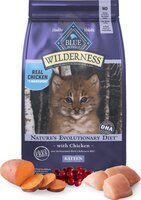
Blue Buffalo
Wilderness
Chicken Recipe For Kittens
Blue Buffalo
Wilderness Chicken Recipe For Kittens
First Five Ingredients
chickenchicken meal
pea protein
tapioca starch
menhaden meal

Blue Buffalo
Indoor Health
Chicken & Brown Rice Recipe For Adult Cats
Blue Buffalo
Indoor Health Chicken & Brown Rice Recipe For Adult Cats
First Five Ingredients
chickenchicken meal
menhaden meal
brown rice
barley
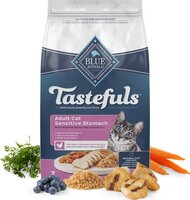
Blue Buffalo
Sensitive Stomach
Chicken & Brown Rice Recipe For Adult Cats
Blue Buffalo
Sensitive Stomach Chicken & Brown Rice Recipe For Adult Cats
First Five Ingredients
chickenchicken meal
brown rice
oatmeal
barley
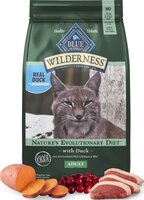
Blue Buffalo
Wilderness
Duck Recipe For Adult Cats
Blue Buffalo
Wilderness Duck Recipe For Adult Cats
First Five Ingredients
duckchicken meal
pea protein
pea
tapioca starch
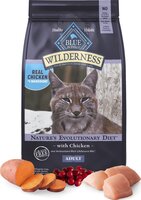
Blue Buffalo
Wilderness
Chicken Recipe For Adult Cats
Blue Buffalo
Wilderness Chicken Recipe For Adult Cats
First Five Ingredients
chickenchicken meal
pea protein
tapioca starch
pea
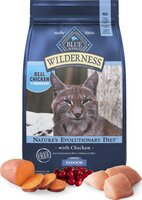
Blue Buffalo
Wilderness
Chicken Recipe For Indoor Adult Cats
Blue Buffalo
Wilderness Chicken Recipe For Indoor Adult Cats
First Five Ingredients
chickenchicken meal
pea protein
pea
tapioca starch
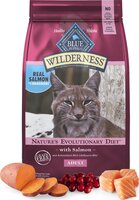
Blue Buffalo
Wilderness
Salmon Recipe For Adult Cats
Blue Buffalo
Wilderness Salmon Recipe For Adult Cats
First Five Ingredients
salmonchicken meal
pea protein
pea
tapioca starch
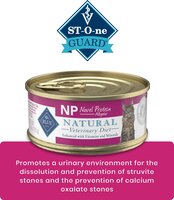
Blue Buffalo
Natural Veterinary Diet
NP Novel Protein Alligator For Cats (Canned)
Blue Buffalo
Natural Veterinary Diet NP Novel Protein Alligator For Cats (Canned)
First Five Ingredients
alligatorwater
potato protein
potato
pea protein
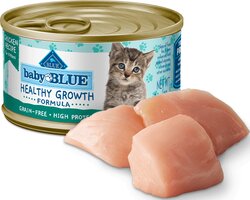
Blue Buffalo
Baby Blue
Grain-Free Chicken Recipe For Kittens
Blue Buffalo
Baby Blue Grain-Free Chicken Recipe For Kittens
First Five Ingredients
chickenchicken broth
salmon oil
potato
guar gum
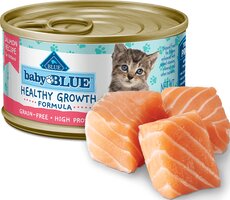
Blue Buffalo
Baby Blue
Grain-Free Salmon Recipe For Kittens
Blue Buffalo
Baby Blue Grain-Free Salmon Recipe For Kittens
First Five Ingredients
salmonchicken
fish broth
chicken liver
pea flour
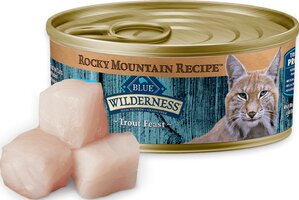
Blue Buffalo
Wilderness Rocky Mountain Recipe
Trout Feast
Blue Buffalo
Wilderness Rocky Mountain Recipe Trout Feast
First Five Ingredients
troutfish broth
whitefish
turkey liver
potato
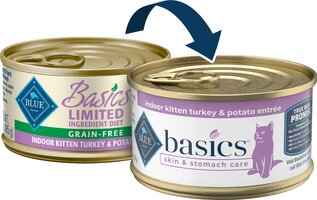
Blue Buffalo
Basics Limited Ingredient Grain-Free
Indoor Kitten Turkey & Potato Entree
Blue Buffalo
Basics Limited Ingredient Grain-Free Indoor Kitten Turkey & Potato Entree
First Five Ingredients
turkeyturkey broth
turkey liver
fish oil
natural flavor
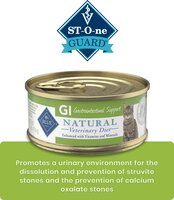
Blue Buffalo
Natural Veterinary Diet
GI Gastrointestinal Support
Blue Buffalo
Natural Veterinary Diet GI Gastrointestinal Support
First Five Ingredients
chickenchicken broth
chicken liver
whitefish
potato
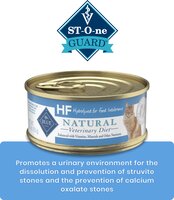
Blue Buffalo
Natural Veterinary Diet
HF Hydrolyzed For Food Intolerance For Cats (Canned)
Blue Buffalo
Natural Veterinary Diet HF Hydrolyzed For Food Intolerance For Cats (Canned)
First Five Ingredients
salmon hydrolysatewater
potato starch
natural flavor
pea fiber
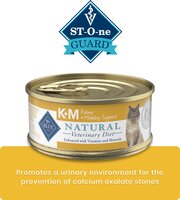
Blue Buffalo
Natural Veterinary Diet
KM Kidney + Mobility Support
Blue Buffalo
Natural Veterinary Diet KM Kidney + Mobility Support
First Five Ingredients
chickenchicken broth
water
potato
potato starch
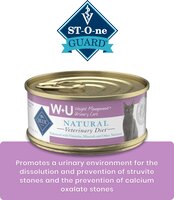
Blue Buffalo
Natural Veterinary Diet
WU Weight Management + Urinary Care
Blue Buffalo
Natural Veterinary Diet WU Weight Management + Urinary Care
First Five Ingredients
chickenchicken broth
chicken liver
water
pea protein
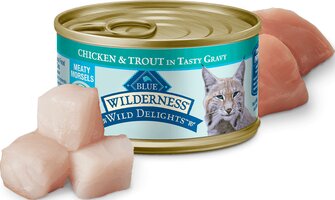
Blue Buffalo
Wilderness Wild Delights
Meaty Morsels Chicken and Trout In Tasty Gravy
Blue Buffalo
Wilderness Wild Delights Meaty Morsels Chicken and Trout In Tasty Gravy
First Five Ingredients
chickenchicken broth
water
trout
chicken liver
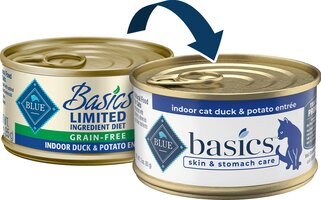
Blue Buffalo
Basics Grain-Free
Indoor Duck & Potato Entree
Blue Buffalo
Basics Grain-Free Indoor Duck & Potato Entree
First Five Ingredients
duckduck broth
potato
pea protein
carrot
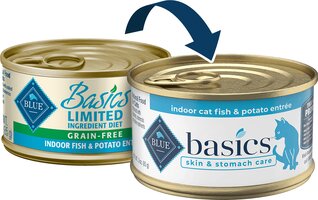
Blue Buffalo
Basics
Indoor Cat Fish & Potato Entrée (Skin & Stomach Care)
Blue Buffalo
Basics Indoor Cat Fish & Potato Entrée (Skin & Stomach Care)
First Five Ingredients
fishfish broth
carrot
potato
pea protein
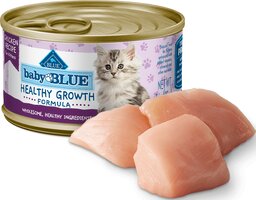
Blue Buffalo
Baby Blue
Chicken Recipe For Kittens
Blue Buffalo
Baby Blue Chicken Recipe For Kittens
First Five Ingredients
chickenchicken liver
chicken broth
dried egg product
fish oil
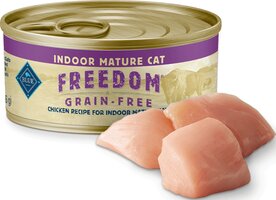
Blue Buffalo
Freedom
Chicken Recipe For Indoor Mature Cats
Blue Buffalo
Freedom Chicken Recipe For Indoor Mature Cats
First Five Ingredients
chickenchicken broth
chicken liver
carrot
sweet potato
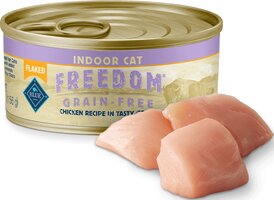
Blue Buffalo
Freedom
Flaked Indoor Chicken Recipe
Blue Buffalo
Freedom Flaked Indoor Chicken Recipe
First Five Ingredients
chickenchicken broth
water
chicken liver
dried egg product
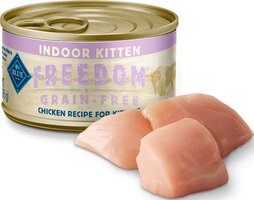
Blue Buffalo
Freedom
Indoor Kitten Chicken Recipe
Blue Buffalo
Freedom Indoor Kitten Chicken Recipe
First Five Ingredients
chickenchicken liver
chicken broth
carrot
sweet potato
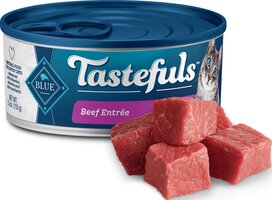
Blue Buffalo
Tastefuls
Beef Entree (Paté)
Blue Buffalo
Tastefuls Beef Entree (Paté)
First Five Ingredients
beefbeef broth
chicken liver
chicken
turkey
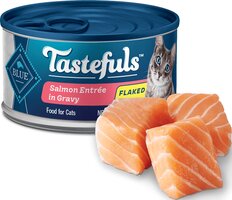
Blue Buffalo
Tastefuls
Salmon Entree In Gravy (Flaked)
Blue Buffalo
Tastefuls Salmon Entree In Gravy (Flaked)
First Five Ingredients
salmonfish broth
water
chicken liver
turkey
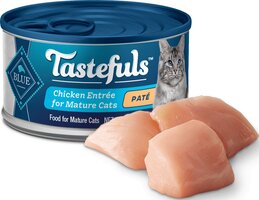
Blue Buffalo
Tastefuls
Chicken Entree For Mature Cats (Paté)
Blue Buffalo
Tastefuls Chicken Entree For Mature Cats (Paté)
First Five Ingredients
chickenchicken broth
chicken liver
natural flavor
brown rice
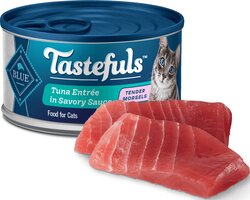
Blue Buffalo
Tastefuls
Tuna Entree In Savory Sauce (Tender Morsels)
Blue Buffalo
Tastefuls Tuna Entree In Savory Sauce (Tender Morsels)
First Five Ingredients
tunafish broth
water
chicken
chicken liver
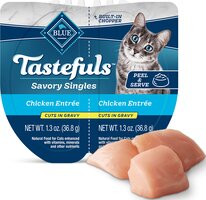
Blue Buffalo
Tastefuls Savory Singles
Chicken Entrée Cuts In Gravy
Blue Buffalo
Tastefuls Savory Singles Chicken Entrée Cuts In Gravy
First Five Ingredients
chickenchicken broth
water
chicken liver
dried egg product
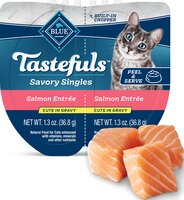
Blue Buffalo
Tastefuls Savory Singles
Salmon Entrée Cuts In Gravy
Blue Buffalo
Tastefuls Savory Singles Salmon Entrée Cuts In Gravy
First Five Ingredients
salmonfish broth
water
chicken
chicken liver
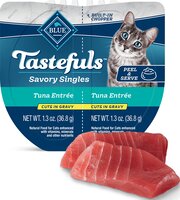
Blue Buffalo
Tastefuls Savory Singles
Tuna Entrée Cuts In Gravy
Blue Buffalo
Tastefuls Savory Singles Tuna Entrée Cuts In Gravy
First Five Ingredients
tunafish broth
chicken
water
chicken liver
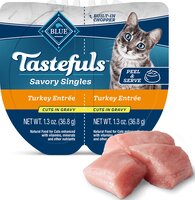
Blue Buffalo
Tastefuls Savory Singles
Turkey Entrée Cuts In Gravy
Blue Buffalo
Tastefuls Savory Singles Turkey Entrée Cuts In Gravy
First Five Ingredients
turkeyturkey broth
water
chicken
chicken liver
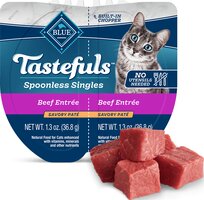
Blue Buffalo
Tastefuls Spoonless Singles
Beef Entrée Savory Paté
Blue Buffalo
Tastefuls Spoonless Singles Beef Entrée Savory Paté
First Five Ingredients
beefbeef broth
chicken
turkey
chicken liver
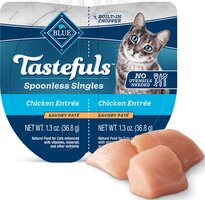
Blue Buffalo
Tastefuls Spoonless Singles
Chicken Entrée Savory Paté
Blue Buffalo
Tastefuls Spoonless Singles Chicken Entrée Savory Paté
First Five Ingredients
chickenchicken liver
chicken broth
natural flavor
brown rice
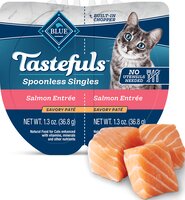
Blue Buffalo
Tastefuls Spoonless Singles
Salmon Entrée Savory Paté
Blue Buffalo
Tastefuls Spoonless Singles Salmon Entrée Savory Paté
First Five Ingredients
salmonchicken liver
fish broth
chicken
natural flavor
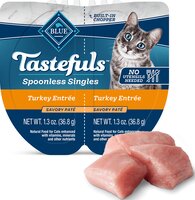
Blue Buffalo
Tastefuls Spoonless Singles
Turkey Entrée Savory Paté
Blue Buffalo
Tastefuls Spoonless Singles Turkey Entrée Savory Paté
First Five Ingredients
turkeychicken
chicken liver
chicken broth
natural flavor
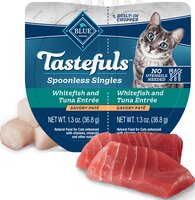
Blue Buffalo
Tastefuls Spoonless Singles
Whitefish and Tuna Entrée Savory Paté
Blue Buffalo
Tastefuls Spoonless Singles Whitefish and Tuna Entrée Savory Paté
First Five Ingredients
whitefishchicken
fish broth
chicken liver
natural flavor
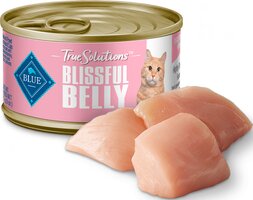
Blue Buffalo
True Solutions
Blissful Belly Digestive Care Formula Canned Cat Food
Blue Buffalo
True Solutions Blissful Belly Digestive Care Formula Canned Cat Food
First Five Ingredients
chickenchicken broth
potato
chicken liver
whitefish
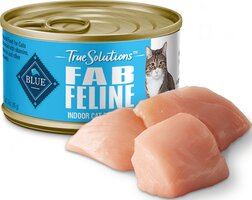
Blue Buffalo
True Solutions
Fab Feline Formula For Indoor Cats (Canned Cat Food)
Blue Buffalo
True Solutions Fab Feline Formula For Indoor Cats (Canned Cat Food)
First Five Ingredients
chickenchicken broth
whitefish
chicken liver
brown rice
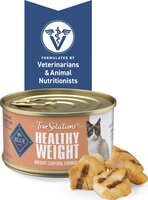
Blue Buffalo
True Solutions
Fit & Healthy Weight Control Formula Canned Cat Food
Blue Buffalo
True Solutions Fit & Healthy Weight Control Formula Canned Cat Food
First Five Ingredients
chickenchicken broth
chicken liver
potato
whitefish
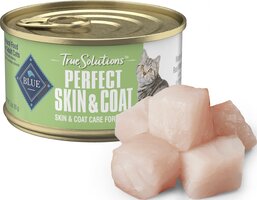
Blue Buffalo
True Solutions
Perfect Coat (Skin and Coat Care Formula) Canned Cat Food
Blue Buffalo
True Solutions Perfect Coat (Skin and Coat Care Formula) Canned Cat Food
First Five Ingredients
whitefishfish broth
potato
pea flour
potato protein
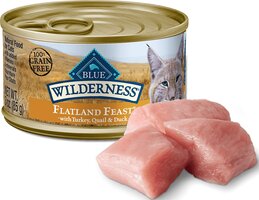
Blue Buffalo
Wilderness
Flatland Feast With Turkey, Quail & Duck For Cats (Canned)
Blue Buffalo
Wilderness Flatland Feast With Turkey, Quail & Duck For Cats (Canned)
First Five Ingredients
turkeychicken
turkey broth
turkey liver
quail
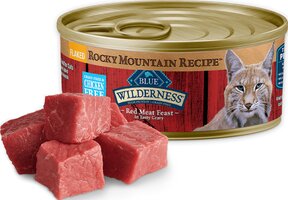
Blue Buffalo
Wilderness Rocky Mountain Recipe
Flaked Red Meat Feast In Tasty Gravy
Blue Buffalo
Wilderness Rocky Mountain Recipe Flaked Red Meat Feast In Tasty Gravy
First Five Ingredients
beefbeef broth
water
turkey
beef liver
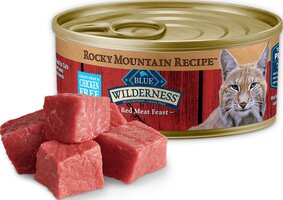
Blue Buffalo
Wilderness Rocky Mountain Recipe
Red Meat Feast
Blue Buffalo
Wilderness Rocky Mountain Recipe Red Meat Feast
First Five Ingredients
beefturkey
beef broth
turkey liver
potato
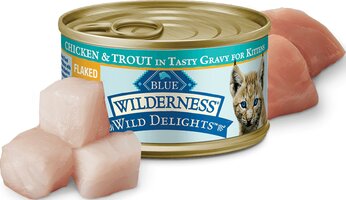
Blue Buffalo
Wilderness Wild Delights
Flaked Chicken & Trout In Tasty Gravy For Kittens
Blue Buffalo
Wilderness Wild Delights Flaked Chicken & Trout In Tasty Gravy For Kittens
First Five Ingredients
chickenchicken broth
water
trout
chicken liver
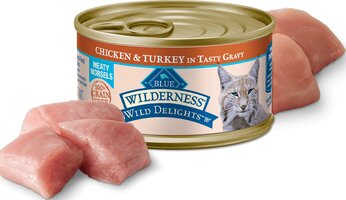
Blue Buffalo
Wilderness Wild Delights
Meaty Morsels Chicken & Turkey In Tasty Gravy
Blue Buffalo
Wilderness Wild Delights Meaty Morsels Chicken & Turkey In Tasty Gravy
First Five Ingredients
chickenchicken broth
water
turkey
chicken liver
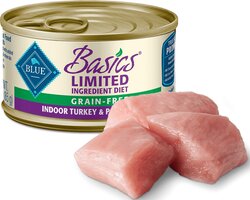
Blue Buffalo
Basics Limited Ingredient Grain-Free
Indoor Turkey & Potato Entree
Blue Buffalo
Basics Limited Ingredient Grain-Free Indoor Turkey & Potato Entree
First Five Ingredients
turkeyturkey broth
turkey liver
potato
natural flavor
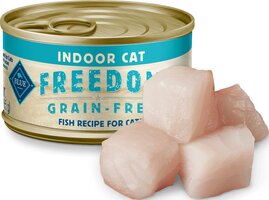
Blue Buffalo
Freedom
Indoor Fish Recipe
Blue Buffalo
Freedom Indoor Fish Recipe
First Five Ingredients
fishfish broth
chicken
chicken liver
carrot
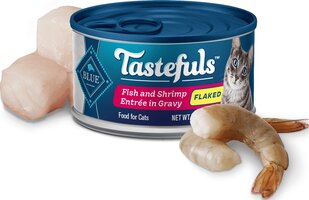
Blue Buffalo
Tastefuls
Fish and Shrimp Entree In Gravy (Flaked)
Blue Buffalo
Tastefuls Fish and Shrimp Entree In Gravy (Flaked)
First Five Ingredients
fishfish broth
water
chicken
chicken liver
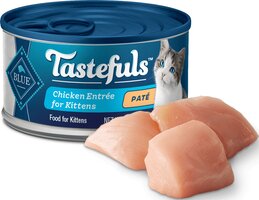
Blue Buffalo
Tastefuls
Chicken Entree For Kittens (Paté)
Blue Buffalo
Tastefuls Chicken Entree For Kittens (Paté)
First Five Ingredients
chickenchicken liver
chicken broth
dried egg product
natural flavor
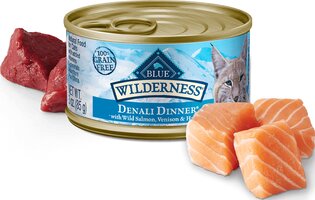
Blue Buffalo
Wilderness
Denali Dinner With Wild Salmon, Venison & Halibut For Cats (Canned)
Blue Buffalo
Wilderness Denali Dinner With Wild Salmon, Venison & Halibut For Cats (Canned)
First Five Ingredients
turkeyturkey broth
salmon
turkey liver
venison
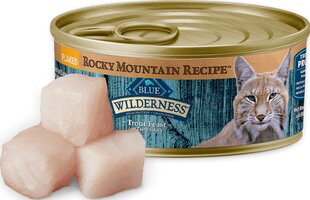
Blue Buffalo
Wilderness Rocky Mountain Recipe
Flaked Trout Feast
Blue Buffalo
Wilderness Rocky Mountain Recipe Flaked Trout Feast
First Five Ingredients
troutturkey broth
water
turkey liver
whitefish
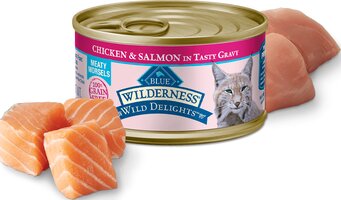
Blue Buffalo
Wilderness Wild Delights
Meaty Morsels Chicken & Salmon In Tasty Gravy
Blue Buffalo
Wilderness Wild Delights Meaty Morsels Chicken & Salmon In Tasty Gravy
First Five Ingredients
chickenchicken broth
water
salmon
chicken liver
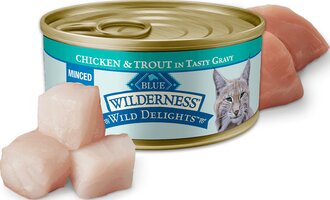
Blue Buffalo
Wilderness Wild Delights
Minced Chicken & Trout In Tasty Gravy
Blue Buffalo
Wilderness Wild Delights Minced Chicken & Trout In Tasty Gravy
First Five Ingredients
chickenchicken broth
water
trout
chicken liver
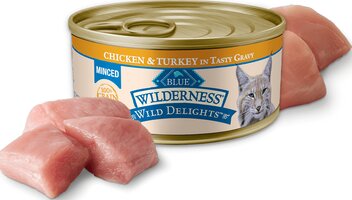
Blue Buffalo
Wilderness Wild Delights
Minced Chicken & Turkey In Tasty Gravy
Blue Buffalo
Wilderness Wild Delights Minced Chicken & Turkey In Tasty Gravy
First Five Ingredients
chickenchicken broth
water
turkey
chicken liver
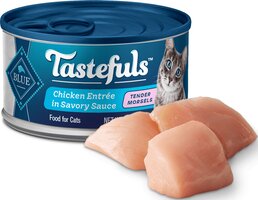
Blue Buffalo
Tastefuls
Chicken Entree In Savory Sauce (Tender Morsels)
Blue Buffalo
Tastefuls Chicken Entree In Savory Sauce (Tender Morsels)
First Five Ingredients
chickenchicken broth
water
chicken liver
dried egg product
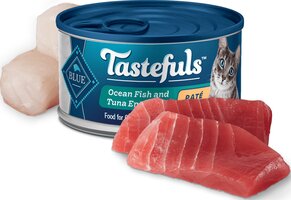
Blue Buffalo
Tastefuls
Ocean Fish & Tuna Entree (Paté)
Blue Buffalo
Tastefuls Ocean Fish & Tuna Entree (Paté)
First Five Ingredients
whitefishfish broth
tuna
chicken
chicken liver
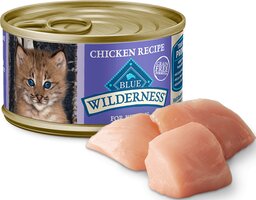
Blue Buffalo
Wilderness
Chicken Recipe For Kittens
Blue Buffalo
Wilderness Chicken Recipe For Kittens
First Five Ingredients
chickenchicken broth
chicken liver
dried egg product
salmon oil
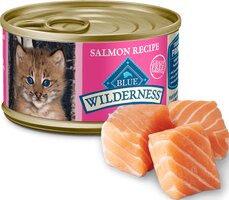
Blue Buffalo
Wilderness
Salmon Recipe For Kittens
Blue Buffalo
Wilderness Salmon Recipe For Kittens
First Five Ingredients
salmonchicken
fish broth
chicken liver
pea flour
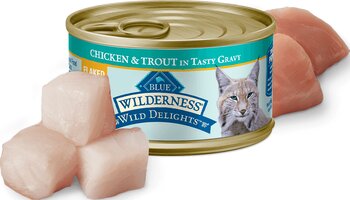
Blue Buffalo
Wilderness Wild Delights
Flaked Chicken & Trout In Tasty Gravy
Blue Buffalo
Wilderness Wild Delights Flaked Chicken & Trout In Tasty Gravy
First Five Ingredients
chickenchicken broth
water
trout
chicken liver
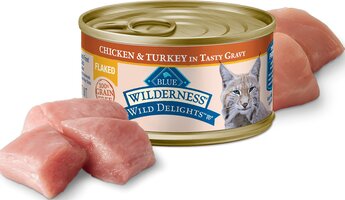
Blue Buffalo
Wilderness Wild Delights
Flaked Chicken & Turkey In Tasty Gravy
Blue Buffalo
Wilderness Wild Delights Flaked Chicken & Turkey In Tasty Gravy
First Five Ingredients
chickenchicken broth
water
turkey
chicken liver
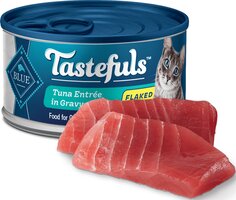
Blue Buffalo
Tastefuls
Tuna Entree In Gravy (Flaked)
Blue Buffalo
Tastefuls Tuna Entree In Gravy (Flaked)
First Five Ingredients
tunafish broth
water
chicken
chicken liver
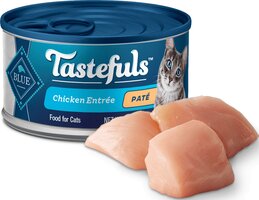
Blue Buffalo
Tastefuls
Chicken Entree (Paté)
Blue Buffalo
Tastefuls Chicken Entree (Paté)
First Five Ingredients
chickenchicken broth
chicken liver
natural flavor
brown rice
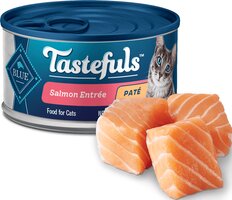
Blue Buffalo
Tastefuls
Salmon Entree (Paté)
Blue Buffalo
Tastefuls Salmon Entree (Paté)
First Five Ingredients
salmonfish broth
chicken liver
chicken
brown rice
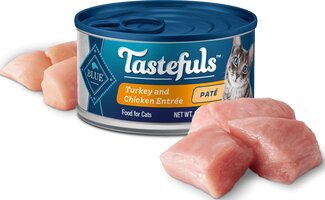
Blue Buffalo
Tastefuls
Turkey and Chicken Entree (Paté)
Blue Buffalo
Tastefuls Turkey and Chicken Entree (Paté)
First Five Ingredients
turkeychicken broth
chicken liver
chicken
natural flavor
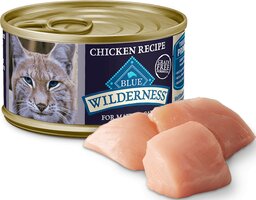
Blue Buffalo
Wilderness
Chicken Recipe For Mature Cats
Blue Buffalo
Wilderness Chicken Recipe For Mature Cats
First Five Ingredients
chickenchicken broth
chicken liver
potato
pea protein
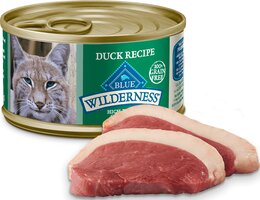
Blue Buffalo
Wilderness
Duck Recipe
Blue Buffalo
Wilderness Duck Recipe
First Five Ingredients
duckturkey broth
chicken liver
potato
natural flavor
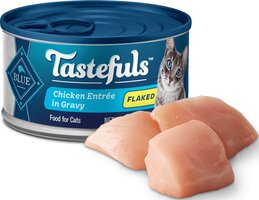
Blue Buffalo
Tastefuls
Chicken Entree In Gravy (Flaked)
Blue Buffalo
Tastefuls Chicken Entree In Gravy (Flaked)
First Five Ingredients
chickenchicken broth
water
chicken liver
dried egg product
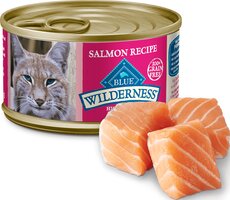
Blue Buffalo
Wilderness
Salmon Recipe
Blue Buffalo
Wilderness Salmon Recipe
First Five Ingredients
salmonfish broth
chicken liver
natural flavor
potato
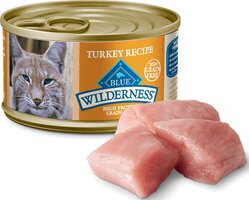
Blue Buffalo
Wilderness
Turkey Recipe
Blue Buffalo
Wilderness Turkey Recipe
First Five Ingredients
turkeyturkey broth
turkey liver
potato
dried egg product
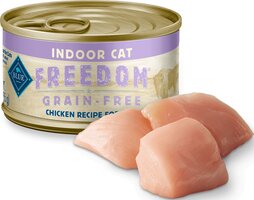
Blue Buffalo
Freedom
Indoor Chicken Recipe
Blue Buffalo
Freedom Indoor Chicken Recipe
First Five Ingredients
chickenchicken broth
chicken liver
carrot
sweet potato
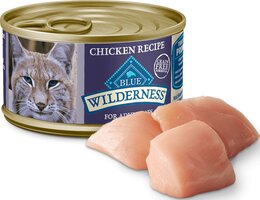
Blue Buffalo
Wilderness
Chicken Recipe
Blue Buffalo
Wilderness Chicken Recipe
First Five Ingredients
chickenchicken broth
chicken liver
potato
natural flavor
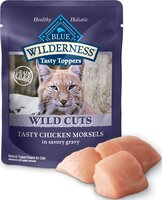
Blue Buffalo
Wilderness Tasty Toppers Wild Cuts
Tasty Chicken Morsels in Savory Gravy
Blue Buffalo
Wilderness Tasty Toppers Wild Cuts Tasty Chicken Morsels in Savory Gravy
First Five Ingredients
chickenchicken broth
water
chicken liver
dried egg product
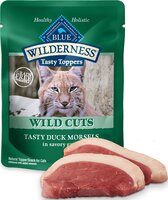
Blue Buffalo
Wilderness Tasty Toppers Wild Cuts
Tasty Duck Morsels in Savory Gravy
Blue Buffalo
Wilderness Tasty Toppers Wild Cuts Tasty Duck Morsels in Savory Gravy
First Five Ingredients
duckchicken broth
water
chicken liver
dried egg product
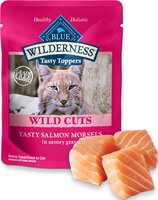
Blue Buffalo
Wilderness Tasty Toppers Wild Cuts
Tasty Salmon Morsels in Savory Gravy
Blue Buffalo
Wilderness Tasty Toppers Wild Cuts Tasty Salmon Morsels in Savory Gravy
First Five Ingredients
salmonchicken broth
water
chicken liver
dried egg product
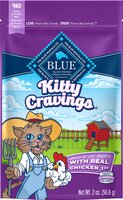
Blue Buffalo
Kitty Cravings
With Real Chicken
Blue Buffalo
Kitty Cravings With Real Chicken
First Five Ingredients
chickenchicken meal
brown rice
barley
oatmeal
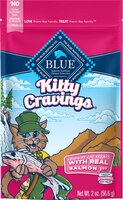
Blue Buffalo
Kitty Cravings
With Real Salmon
Blue Buffalo
Kitty Cravings With Real Salmon
First Five Ingredients
salmonchicken meal
brown rice
barley
oatmeal
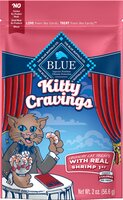
Blue Buffalo
Kitty Cravings
With Real Shrimp
Blue Buffalo
Kitty Cravings With Real Shrimp
First Five Ingredients
shrimpchicken meal
brown rice
barley
oatmeal
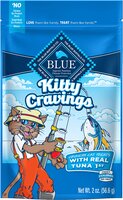
Blue Buffalo
Kitty Cravings
With Real Tuna
Blue Buffalo
Kitty Cravings With Real Tuna
First Five Ingredients
tunachicken meal
brown rice
barley
oatmeal
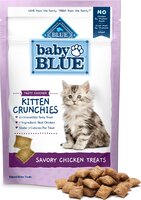
Blue Buffalo
Baby Blue
Kitten Crunchies Savory Chicken Treats
Blue Buffalo
Baby Blue Kitten Crunchies Savory Chicken Treats
First Five Ingredients
chickenchicken meal
brown rice
barley
oatmeal
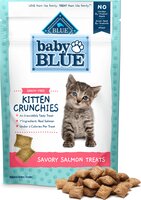
Blue Buffalo
Baby Blue
Kitten Crunchies Savory Salmon Treats
Blue Buffalo
Baby Blue Kitten Crunchies Savory Salmon Treats
First Five Ingredients
salmonchicken meal
potato starch
pea
dried brewers yeast
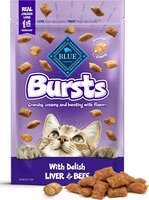
Blue Buffalo
Bursts
With Delish Liver & Beef
Blue Buffalo
Bursts With Delish Liver & Beef
First Five Ingredients
chicken liverchicken meal
chicken fat
brown rice
barley
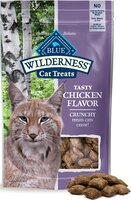
Blue Buffalo
Wilderness Crunchy Cat Treats
Chicken Flavor
Blue Buffalo
Wilderness Crunchy Cat Treats Chicken Flavor
First Five Ingredients
chickenchicken meal
potato starch
pea
dried brewers yeast
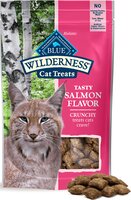
Blue Buffalo
Wilderness Crunchy Cat Treats
Salmon Flavor
Blue Buffalo
Wilderness Crunchy Cat Treats Salmon Flavor
First Five Ingredients
salmonchicken meal
potato starch
pea
dried brewers yeast
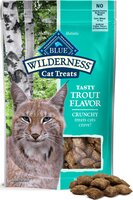
Blue Buffalo
Wilderness Crunchy Cat Treats
Trout Flavor
Blue Buffalo
Wilderness Crunchy Cat Treats Trout Flavor
First Five Ingredients
troutchicken meal
potato starch
pea
dried brewers yeast
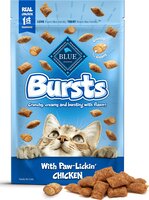
Blue Buffalo
Bursts
With Paw-Lickin' Chicken
Blue Buffalo
Bursts With Paw-Lickin' Chicken
First Five Ingredients
chickenchicken meal
chicken fat
brown rice
barley
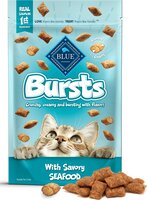
Blue Buffalo
Bursts
With Savory Seafood
Blue Buffalo
Bursts With Savory Seafood
First Five Ingredients
salmonbrown rice
tuna meal
barley
pork fat
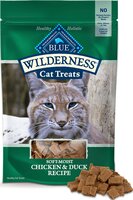
Blue Buffalo
Wilderness Soft-Moist Cat Treats
Chicken & Duck Recipe
Blue Buffalo
Wilderness Soft-Moist Cat Treats Chicken & Duck Recipe
First Five Ingredients
chickenduck
potato
vegetable glycerin
gelatin
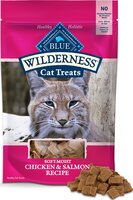
Blue Buffalo
Wilderness Soft-Moist Cat Treats
Chicken & Salmon Recipe
Blue Buffalo
Wilderness Soft-Moist Cat Treats Chicken & Salmon Recipe
First Five Ingredients
chickensalmon
potato
vegetable glycerin
gelatin
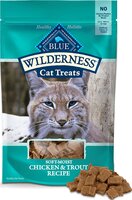
Blue Buffalo
Wilderness Soft-Moist Cat Treats
Chicken & Trout Recipe
Blue Buffalo
Wilderness Soft-Moist Cat Treats Chicken & Trout Recipe
First Five Ingredients
chickentrout
potato
vegetable glycerin
gelatin
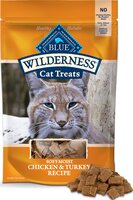
Blue Buffalo
Wilderness Soft-Moist Cat Treats
Chicken & Turkey Recipe
Blue Buffalo
Wilderness Soft-Moist Cat Treats Chicken & Turkey Recipe
First Five Ingredients
chickenturkey
potato
vegetable glycerin
gelatin
